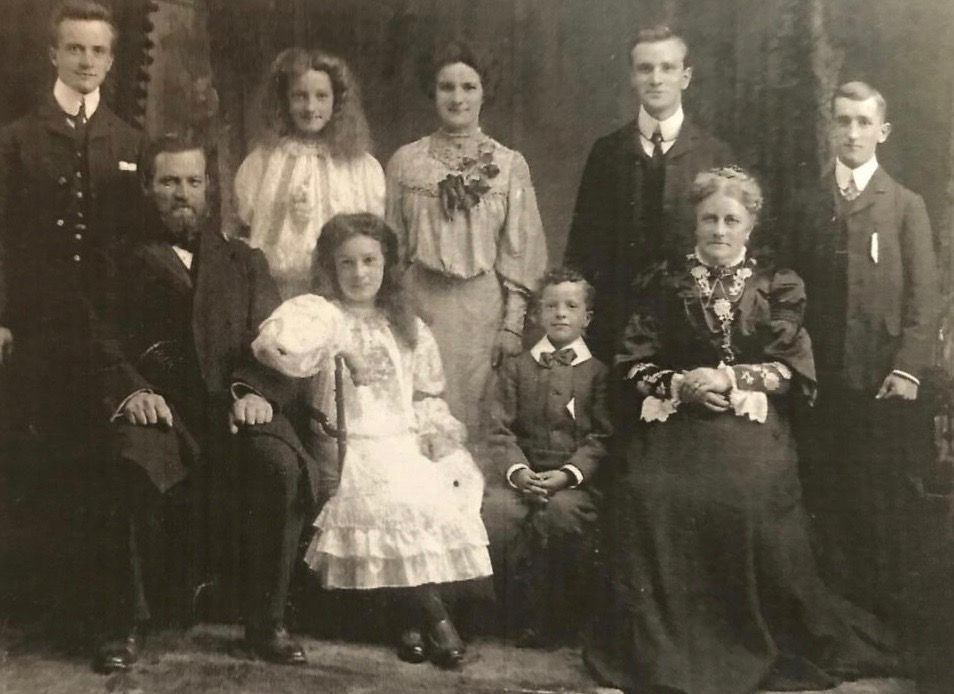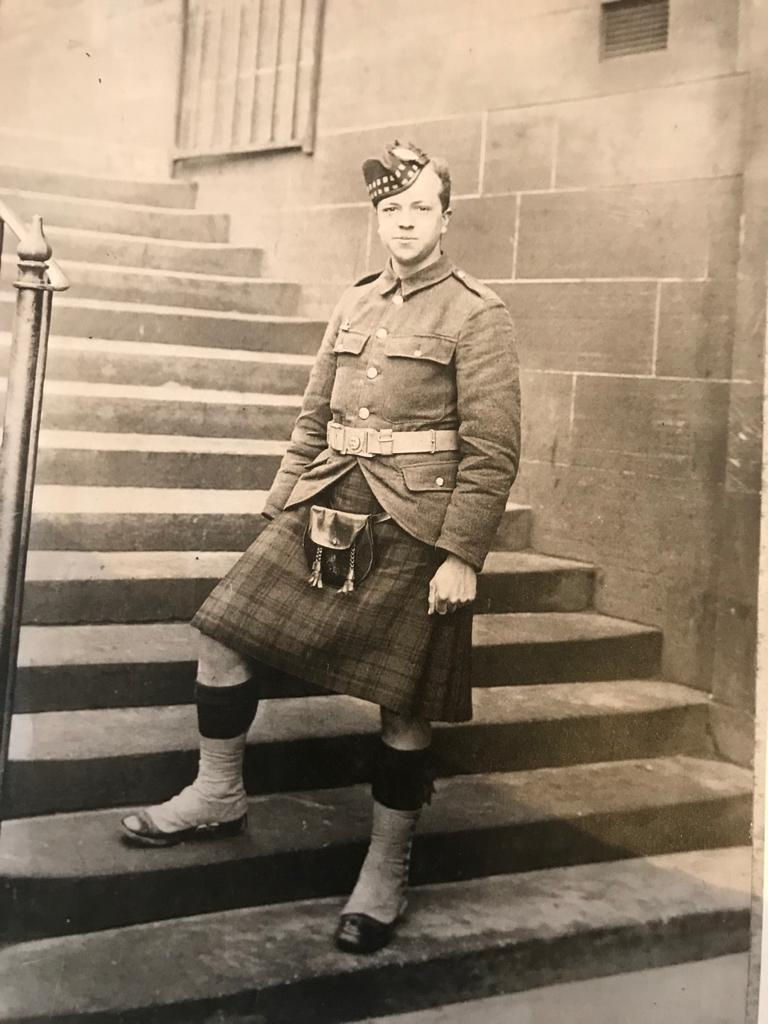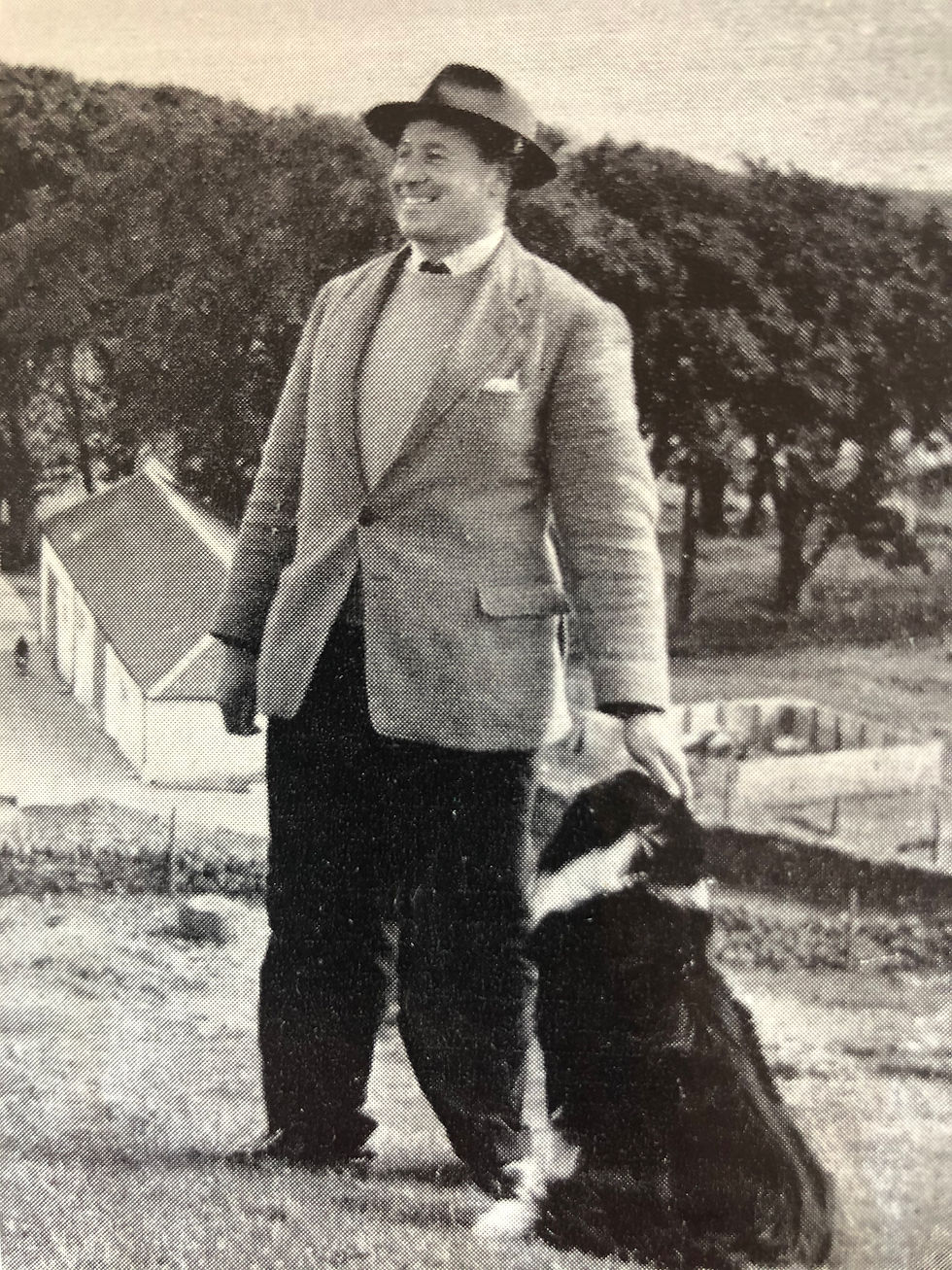“Most people do not recognize when enough material belongings are enough. They often show disdain of those that seem to lack the ambition to crave for more. The happiest are those satisfied with what they have already got. They know happiness is not found in amassing material belongings.” Peter McSporran
Flora, my stepmother, had a large impact on our family’s lives. Good in some cases and unfortunate certainly in one. My opinion of my father will be integrated within my story as he had a substantial influence on who I believe I am. As a means of introducing him, I have included a copy of one of the many articles written about him. He was both tough in mind and all action in business; in contrast to his personal life. Poor health forced him to retire early from farming.
Medical Update
Little news on this front with no scan results as yet. On Thursday I had my PET scan. Everything was going well until about two minutes before receiving my dose of whatever nuclear liquid they use for the purpose of the scan. Thie procedure entails you being put in a room connected to a drip line in isolation. Through a hole in the wall, a lead cylinder appears and a nurse arrives to introduce some of the liquid it contains into your system through your cannula. Within an hour you then have a scan with the nuclear substance acting as a tracer. Possible areas of concern show up and are called “hotspots.” You do not want these.
No sooner am I in the room and then I smell it. “Sheep shit.” Mind you, it could have been goat, our neighbour keeps both. No chance of any sheep being in here I think, check shoes. Yes, sheep shit on the sole of the shoe, thank god not dog shit. Being an ex-farmer I can live with that. But will the nursing staff? I thought do not worry, I will undress for the scan. No such luck. Being metal free I was introduced to the scanning machine fully clothed including sheep shit shoes with the soles pointing directly to the viewing window of the scanning team. Lacking a good knowledge of the language, I believe the animated conversation that took place as they removed me was more about the manure on my shoes than my health.
My Stepmother
In the wake of my mother, Grace’s death, Flora married my father the following year. Unbeknownst to my sister, Morag and I, Flora and my father had embarked on a romantic relationship prior to my mother’s death. A baby girl was born and put up for adoption. Once again, we were totally unaware of this secret until much later on in our lives. It is, therefore, appropriate Flora gets a mention now, before I write about my father. She was involved in my early years following my Mother’s death and had a major impact on the path I took to adulthood.

Flora, like her mother seemingly, had dark Celtic features. Dark hair and brown eyes. We McSporrans were grey or blue-eyed with brown or in my case fair hair. She was extremely striking, she knew her mind and certainly required people to recognise her perceived station. She was hard-working in support of my father. Unfortunately, she was not the warmest to her stepchildren. From memory, I was never presented with a hug. More fortunately, I never had to endure a wallop either. Mind you, in those times in the Presbyterian West Coast of Scotland, such shows of affection were extremely rare and certainly never as a form of greeting or farewell.
Much of what I write about Flora’s family is extracted from her own personal correspondence. In it she tells us her Grandfather and Grandmother farmed at Lettermay, Lochgoilhead, Argyll. Her grandfather was the owner of Lettermay Estate, he also had a number of butchery businesses in Hamilton, Central Scotland, and travelled between there and Lochgoilhead. They employed a young lady called Margaret Cameron. Margaret left home when she was young because of her dislike for her stepfather. She seemed to have been popular with her father-in-law to be, William, the patriarch of the family. A known disciplinary who “ran the family affairs with a rod of iron.” My stepmothers’ own words. However, all hell broke loose when his son, Robert, declared he was wedding the “servant girl.” Oh, the shame and the scandal! It appears the old man died shortly after this event without leaving a will and in the ensuing and inevitable family battle, his daughters took over the farm. I do remember that my stepmother had two aunts farming in Lochgoilhead when she married my father. Of the older brothers, Tom had emigrated to Canada, Bill was a veterinary practitioner, and Alex had taken a divinity degree. That left the youngest son, Robert, Flora’s father, who remained on the farm. Robert left with his young wife, the ex servant girl when his sisters took control. Perhaps Alex prevented any real bloodshed with his godly influence.

I am unaware of how or why Flora, her father and two of her brothers ended up on the Isle of Mull. One of her brothers, Dougie, worked on the estate and, among other duties, was in charge of machinery and vehicle maintenance, while his wife worked in the farm office. I remember them well, Dougie was a really likeable guy. Her other brother Willie, worked in a “Browns” hardware shop in Tobermory where we bought both our whisky and fishing tackle. My father did not drink whisky, regrettably, I was too young. The whisky was just for visitors' use. Her other brother, Robert, was an officer in the Merchant Marine, and her sister, Marigold was married and resided in Glasgow. Marigold seemed to be the closest family member to my stepmother and visited us from time to time.
Flora and my Dad married in 1960, they had two children together, Archie and Fiona, my half-sister and half-brother. My other half-sister, Mandy; a full sister to Archie and Fiona was still unknown to us. Mandy only appeared very much later as a revelation, and as it turns out, an extremely favourable addition to the family.
Flora always treated me with respect, although I was made to feel more of a visitor than a member in the family home during school holidays. Unfortunately, the same cannot be said with her relationship with Morag, who had remained at home. Perhaps she refused to leave or Flora and my father decided she should stay? Flora and Morag’s relationship became uncomfortably turbulent with time and remained so until Morag left for a new life in what was previously known as Rhodesia. Morag was very close to her half-brother Archie. Meanwhile, Archie and Fiona do not have a particularly close relationship, and my perception is that Flora may well be the underlying cause. Who knows, they are not telling? Flora came from two generations of fractured families. Occasionally, I have wondered if it was perhaps an inherent pattern. I do know that all traces of my birth mother left the house when I did. Not unusual when a matrimonial change takes place. I lost my mother both physically and tangibly. From the time of my father’s death in 1987, until Flora’s death in 2019, I never saw or spoke to Flora at her wish. Following her death, I have subsequently seen that she did claim to like me in letters to my sister Mandy. I talk about half brothers and half-sisters now for clarity of family structure, but in fact, in daily life and in future where mentioned in this blog, they will be referred to as my brothers and sisters. There is no differential and I enjoy and feel close to them all. Perhaps distance helps with closeness in a family?
My father, “The Man on the Hill”
As a means of introduction to my father I use the following article which appeared in the “Campbeltown Courier.” A slightly embellished account of a similar one also appeared in the “People’s Journal”.

My father featured in many farming magazines and other press mediums in the fifties and sixties before his retirement due to ill health. Being naturally lazy, it also allows me to only write the equivalent of half a blog this week. Nothing like copy and paste to make life easier, especially having learned the practice through consultancy.
Farmer extraordinary - Campbeltown Courier, 1969
“And we’ll be known as the folks who live on the hill” could well refer to Mr & Mrs Archie MacSporran of Killiechronan, Mull. Their story is one of the success stories in the world of hill farming.
Archie MacSporran was born on the farm “Corputechan’ at Bellochantuy, near Campbeltown, grew up in the farming community and became a farmer himself. Today he is the main force, indeed, if genius be born of a capacity for taking pains, the genius, behind the thriving multi-enterprise known as the Killiechronan Estate.
The beautiful hills of the Highlands and Islands are the unforgiving hills where farming are concerned. One month of neglect brings more trouble than a poor year of husbandry may inflict on the man who farms the lush lands of the lowlands. Killiechronan is an example of what can be done to reclaim land and put it to its best use.
Killiechronan is the example of what MUST be done if island hill farming is to prosper. There was money available for the Killiechronan project on a scale beyond the means of most hill farmers, but even here the money had to be well spent and once spent to work as the plough works. A continual turning over. Movement is the keynote for Killiechronan’s progress.
Archie MacSporran has an office which would do justice to a city tycoon. Wall-to-wall carpeting and modern furnishings, combined with up-to-date equipment, create an atmosphere of luxury and well-being. There is an air of quiet efficiency in the office building which was built and equipped by the craftsmen working on the estate, but you’ll seldom find Mr MacSporran at ease in his office.
After the First World War the popular song posed the question “How yer gonna keep ‘em down on the farm after they’ve seen Paree?”. The Chalmers Property Investment Company – Killiechronan Estates – have no such problem. Employees stay with the organisation because it looks after their interests, and it provides them with interesting jobs. While it may not provide the bright lights and soft music of the Paris boulevards, it does offer a diversity of occupations.
Farming, forestry, building and construction work, plant maintenance, market gardening, loch fishing – all have a part in the company’s operations. And there is always some project to capture the interest of all concerned.
Archie MacSporran came to Mull some 16 years ago and found Killiechronan consisting of three sheep farms with about 4,000 acres, a small flock of Blackface sheep and no cattle. Today it covers over 15,000 acres and carries 3,000 Blackfaced breeding ewes and 800 ewe hoggs. The use of the land is balanced by the herd of over 200 pedigree Galloway cattle – 80 pedigree Aberdeen-Angus and 120 Commercial cattle.
Killiechronan is still a hill farm, but due to the intensive scheme of land reclamation and development, it is probably the most successful one in the West of Scotland. The stock raised on these lands are prize-winners at the leading shows and fetch top prices at market. Prices of up to £1,000 have been received for Aberdeen-Angus and Galloway bulls bred and raised at Killiechronan.
Mr MacSporran is in charge of what could well be called a “do it yourself” estate. The buildings are maintained by the building trade workers employed in the organization. New buildings are erected by them, not only for Killiechronan, but for outside customers as well. And most building materials are on sale to the public at the estate offices.
One of the major problems facing any farmer bent on developing hill land is that of draining and fencing. All this work is carried out by the specialists employed, and the timber required comes from the estate’s 150 acres of woodland. The estate sawmill turns out the timber in its required forms for home use and sale.
Archie MacSporran has, on every suitable occasion, laid his great store of knowledge, experience and ‘know-how’ at the disposal of authority. He is acknowledged by those who know hill farming from the inside to be a man of perception and sound common-sense. The Killiechronan story could well be the blueprint for Government policy for the Highlands and Islands where farming is concerned.
There is no ‘closed’ shop attitude at Killiechronan.
What they have learned through experience is at the disposal of any official body, or other private undertakings, wishing to better the conditions in hill farming on the islands.
Authority could do worse than sit at the knee of Kintyre born Archie MacSporran when it comes to deciding what help is needed to rescue hill farming now in the hands of worthy men who do not have the capital to do what Killiechronan have shown can, and must be done.
As chairman and moving spirit behind the newly-formed marketing society – West Highland Livestock Producers Ltd – Mr MacSporran has been instrumental in bringing about a long-awaited scheme which ensures the island farmer a guaranteed price for his stock.
The scheme has the blessing of the Highlands and Islands Development Board who have given financial aid. The stock are taken to Craignure where a weigh-bridge has been installed and here they are sold by grade and weight without loss through wastage on the journey to the mainland.
The scheme is popular with farmers who are now assured of a stable market even in bad times.
Living on a hill as he does, Archie MacSporran can look out of his window across beautiful Loch-na-Keal to the distant hills beyond. He works as he lives – looking outwards and onwards.”
Next time I will share a bit more about my father and introduce you to “Bees.” The ones in your head not in hives.
Disclaimer: Copyright Peter McSporran. The content in this blog represents my personal views and does not reflect corporate entities.
Comments